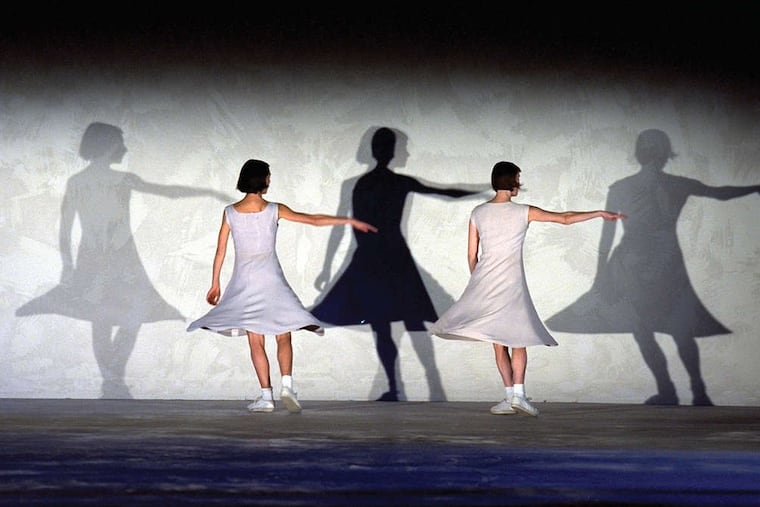Art: Repetition as a means of understanding
Like Mother Nature - where would we all be without DNA? - Gertrude Stein was fond of repetition. As she wrote in her novel The Making of Americans, "Repeating is the whole of living and by repeating comes understanding."

Like Mother Nature - where would we all be without DNA? - Gertrude Stein was fond of repetition. As she wrote in her novel
The Making of Americans
, "Repeating is the whole of living and by repeating comes understanding."
Well, I wonder. Or I did until I watched a good portion of a nearly hour-long film called Fase at the Institute of Contemporary Art.
The film, by Belgian Thierry De Mey, focuses on two female dancers as they execute a series of synchronized spins and movements that suggest vigorous calisthenics. One of the dancers, Anne Teresa De Keersmaeker, is also the choreographer.
The dancers, dressed in simple white shifts, perform in several film-noirish environments to minimalist music by the American composer Steve Reich. Fase is a paean not only to repetitive motion but to elemental sound that recycles.
I expected the film to become boring after a few minutes, but it didn't. In fact, one loses track of time because the repetition isn't absolute. The dancers go subtly in and out of synch, the camera moves in and out, the music becomes mesmerizing.
So, in this case repetition leads, if not to understanding, at least to elevated consciousness. To quote Dr. Strangelove's nemesis, Gen. Jack D. Ripper, the film generates a marvelous "purity of essence."
Fase is one of three elements in a small ICA exhibition called "Each One As She May" that was organized by students in Penn's Spiegel Contemporary Art Freshman Seminar. The show also includes a freestanding aural piece by Reich called Come Out and a suite of drawings by American artist Glenn Ligon in coal dust and oil stick that extrapolate variations of the phrase "Negro sunshine," which also comes from a Stein story.
Ligon's drawings express the limitless potential of variations in simple repetition concisely, but the dancers achieve this with more elegance and sensuality.
In the adjoining gallery, Scots artist Karla Black has constructed a monumental site-specific installation that mesmerizes not through repetition but by creating an evanescent atmosphere of soft color, fragile textures, and dazzling light.
Practically in Shadow consists of a horizontal field on the floor made mostly of pastel-colored, powdered plaster that's juxtaposed against a vertical hanging of diaphanous polyethylene in baby blue and pink.
The piece is so ethereal and atmospheric that it seems almost an illusion, especially the hanging part. The "moonscape" floor looks like a precipitate of cosmic dust. It's a confectionary landscape that injects fantasy and whimsy into a universal condition of existence, endless entropy.
Remembering Gettysburg. We're on the verge of the 150th anniversary of the Battle of Gettysburg, the three-day cataclysm at the turning point of the Civil War that claimed more than 50,000 casualties on both sides.
The Reading Public Museum is marking this grim milestone with an exhibition of paintings devoted to the Civil War by Mort Künstler, whose website describes him as "the premier historical artist in America."
Many artists, beginning with Winslow Homer, have depicted various aspects of the war, from the tedium of camp life to rousing cavalry charges. Photographer Timothy O'Sullivan went so far as to show us the true face of Gettysburg, the bloated corpses on the battlefield.
There aren't dead soldiers at the now-"family friendly" Reading Museum. The majority of Künstler's approximately 30 images aren't even specific to Gettysburg; they depict a variety of scenes, some quite benign, in different war locales.
Künstler's style is precisely illustrational and often dramatically cinematic, like film stills. His colors are vigorous, and his lighting is precisely calibrated to illuminate every detail, as in a 1950s Technicolor movie.
He's especially skillful with scenes set at night or in snow-covered landscapes, seen in the paintings Shenandoah Strategy and The Gray Ghost.
Generally, the sense of the war that these paintings convey is anodyne. The closest Künstler comes to a tragic dimension is The Angel of the Battlefield, in which he depicts Clara Barton and Walt Whitman tending to wounded troops.
There are some rousing action scenes, such as Rendezvous With Destiny, in which troops gallop through a town. Curiously, the most famous assault of the war, Pickett's charge on the final day of Gettysburg, is a static line of Confederates waiting for the command to meet what would prove to be their doom.
Although Künstler is a talented narrative painter, this show falls short of telling the story of Gettysburg or of the war generally; it's a group of tangentially related visual fragments.
If you're curious about the famous battle, a brief video fills in the story. As an added attraction for gun enthusiasts, the show includes a collector's edition of a replica Henry repeating rifle, which was used in the war, engraved with vignettes by Künstler.
Art: Now Now Now . . . and Then
EndText